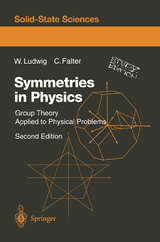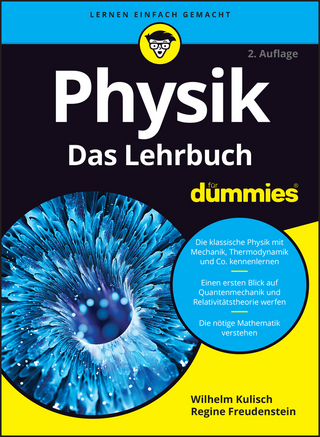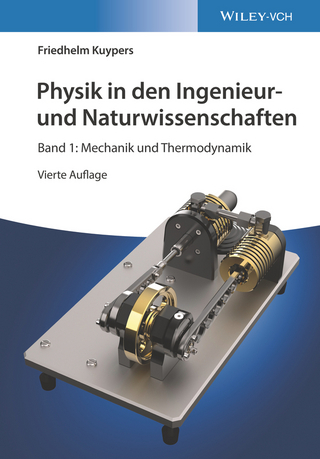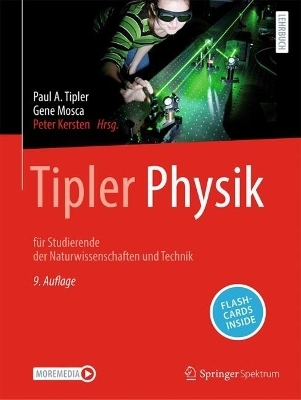
Symmetries in Physics
Springer Berlin (Verlag)
978-3-642-97031-3 (ISBN)
- Titel erscheint in neuer Auflage
- Artikel merken
1. Introduction.- 2. Elements of the Theory of Finite Groups.- 2.1 Symmetry and Group Concepts: A Basic Example.- 2.2 General Theorems on Group Theory.- 2.3 Conjugacy Classes.- 3. Discrete Symmetry Groups.- 3.1 Point Groups.- 3.1.1 Symmetry Elements.- 3.1.2 Proper Point Groups.- 3.1.3 Improper Point Groups.- 3.2 Colour Groups and Magnetic Groups.- 3.3 Double Groups.- 3.4 Lattices, the Translation Group and Space Group.- 3.4.1 Normal Space Groups.- 3.4.2 Colour and Magnetic Space Groups.- 3.4.3 Double Space Groups.- 3.5 Permutation Groups.- 3.6 Other Finite Groups.- 4. Representations of Finite Groups.- 4.1 Linear Spaces and Operators.- 4.1.1 Linear and Unitary Spaces.- 4.1.2 Linear Operators.- 4.1.3 Special Operators and Eigenvalues.- 4.2 Introduction to the Theory of Representations.- 4.2.1 Operator Representations by Matrices.- 4.2.2 Equivalent Representations and Characters.- 4.2.3 Reducible and Irreducible Representations.- 4.2.4 Orthogonality Theorems.- 4.2.5 Subduction. Reality of Representations.- 4.3 Group Algebra.- 4.3.1 The Regular Representation.- 4.3.2 Projection Operators.- 4.4 Direct Products.- 4.4.1 Representations of Direct Products of Groups.- 4.4.2 The Inner Direct Product of Representations of a Group. Clebsch-Gordan Expansion.- 4.4.3 Simply Reducible Groups.- 5. Irreducible Representations of Special Groups.- 5.1 Point and Double Point Groups.- 5.2 Magnetic Point Groups. Time Reversal.- 5.3 Translation Groups.- 5.4 Permutation Groups.- 5.5 Tensor Representations.- 5.5.1 Tensor Transformations. Irreducible Tensors.- 5.5.2 Induced Representations.- 5.5.3 Irreducible Tensor Spaces.- 5.5.4 Direct Products and Their Reduction.- 6. Tensor Operators and Expectation Values.- 6.1 Tensors and Spinors.- 6.2 The Wigner-Eckart Theorem.- 6.3 Eigenvalue Problems.- 6.4 Perturbation Calculus.- 7. Molecular Spectra.- 7.1 Molecular Vibrations.- 7.1.1 Equation of Motion and Symmetry.- 7.1.2 Determination of Eigenvalues and Eigenvectors.- 7.1.3 Selection Rules.- 7.2 Electron Functions and Spectra.- 7.2.1 Symmetry in Many-Particle Systems.- 7.2.2 Symmetry-Adapted Atomic and Molecular Orbitals.- 7.2.3 The Hückel Method and Ligand Field Theory.- 7.3 Manv-Electron Problems.- 7.3.1 Permutation Symmetry.- 7.3.2 Point and Permutation Symmetry. Molecular States.- 7.3.3 The H2 Molecule.- 8. Selection Rules and Matrix Elements.- 8.1 Selection Rules of Tensor Operators.- 8.2 The Jahn-Teller Theorem.- 8.2.1 Spinless States.- 8.2.2 Time Reversal Symmetry.- 8.3 Radiative Transitions.- 8.4 Crystal Field Theory.- 8.4.1 Crystal Field Splitting of Energy Levels.- 8.4.2 Calculation of Splitting.- 8.5 Independent Components of Material Tensors.- 9. Representations of Space Groups.- 9.1 Representations of Normal Space Groups.- 9.1.1 Decompositions into Cosets.- 9.1.2 Induction of the Representations of R.- 9.2 Allowable Irreducible Representations of the Little Group Gk.- 9.2.1 Projective Representations. Representations with a Factor System for G0k = Gk/T.- 9.2.2 Vector Representations of the Group ?k = Gk/Tk.- 9.2.3 Representations of Double Space Groups. Spinor Representations.- 9.3 Projection Operators and Basis Functions.- 9.4 Representations of Magnetic Space Groups.- 9.4.1 Corepresentations of Magnetic Space Groups.- 9.4.2 Time Reversal Symmetry in ?II Groups.- 10. Excitation Spectra and Selection Rules in Crystals.- 10.1 Spectra — Some General Statements.- 10.1.1 Bands and Branches.- 10.1.2 Compatibility Relations.- 10.2 Lattice Vibrations.- 10.2.1 Equation of Motion and Symmetry Properties.- 10.2.2 Vibrations of the Diamond Lattice.- 10.3 Electron Energy Bands.- 10.3.1 Symmetrization of Plane Waves.- 10.3.2 Energy Bands and Atomic Levels.- 10.4 Selection Rules for Interactions in Crystals.- 10.4.1 Determination of Reduction Coefficients.- 10.4.2 General Selection Rules.- 10.4.3 Electron-Phonon Interaction.- 10.4.4 Electron-Photon Interaction: Optical Transitions.- 10.4.5 Phonon-Photon Interaction.- 11. Lie Groups and Lie Algebras.- 11.1 General Foundations.- 11.1.1 Infinitesimal Generators and Defining Relations.- 11.1.2 Algebra and Parameter Space.- 11.1.3 Casimir Operators.- 11.2 Unitary Representations of Lie Groups.- 11.3 Clebsch-Gordan Coefficients and the Wigner-Eckart Theorem.- 11.4 The Cartan-Weyl Basis for Semisimple Lie Algebras.- 11.4.1 The Lie Group ?U(n, ?) and the Lie Algebra An?1.- 11.4.2 The Cartan-Weyl Basis.- 12. Representations by Young Diagrams. The Method of Irreducible Tensors.- 13. Applications of the Theory of Continuous Groups.- 13.1 Elementary Particle Spectra.- 13.1.1 General Remarks.- 13.1.2 Hadronic States.- 13.1.3 Colour States of Ouarks.- 13.1.4 A Possible ?U (4) Classification.- 13.2 Atomic Spectra.- 13.2.1 Russell-Saunders (LS) Coupling.- 13.2.2 jj Coupling.- 13.3 Nuclear Spectra.- 13.3.1 jj-JI Coupling.- 13.3.2 LSI Coupling.- 13.4 Dynamical Symmetries of Classical Systems.- 14. Internal Symmetries and Gauge Theories.- 14.1 Internal Symmetries of Fields.- 14.2 Gauge Transformations of the First Kind.- 14.2.1 U (1) Gauge Transformations.- 14.2.2 ?U (n) Gauge Transformations.- 14.3 Gauge Transformations of the Second Kind.- 14.3.1 U (1) Gauge Transformations of the Second Kind.- 14.3.2 ?U(n) Gauge Transformations of the Second Kind.- 14.3.3 A Differential Geometric Discussion of the Yang-Mills Fields.- 14.4 Gauge Theories with Spontaneously Broken Symmetry.- 14.4.1 General Remarks.- 14.4.2 Spontaneous Breaking of a Gauge Symmetry of the First Kind: Goldstone Model.- 14.4.3 Spontaneous Breaking of an Abelian Gauge Symmetry of the Second Kind: Higgs-Kibble Model.- 14.5 Non-Abelian Gauge Theories and Symmetry Breaking.- 14.5.1 The Glashow-Salam-Weinberg Model of the Electro-Weak Interaction.- 14.5.2 Symmetry Breaking in the Glashow-Salam-Weinberg Model.- 14.5.3 Grand Unified Theories: General Remarks.- 14.5.4 ?U (5) Group and Georgi-Glashow Model.- 14.5.5 Some Consequences of ?U (5) Theory.- Appendices.- References.- Additional References.
| Erscheint lt. Verlag | 14.4.2014 |
|---|---|
| Reihe/Serie | Springer Series in Solid-State Sciences ; 64 |
| Verlagsort | Berlin |
| Sprache | englisch |
| Maße | 155 x 235 mm |
| Einbandart | Paperback |
| Themenwelt | Naturwissenschaften ► Physik / Astronomie ► Allgemeines / Lexika |
| ISBN-10 | 3-642-97031-1 / 3642970311 |
| ISBN-13 | 978-3-642-97031-3 / 9783642970313 |
| Zustand | Neuware |
| Haben Sie eine Frage zum Produkt? |
aus dem Bereich



